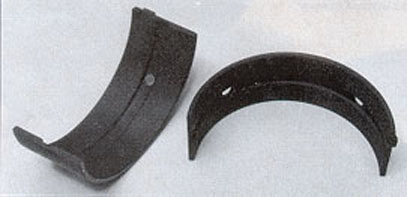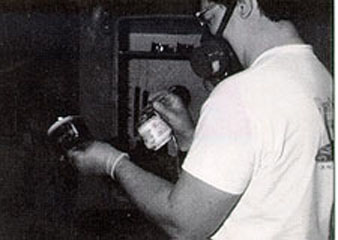I never would have believed you could get those kind of results
from a glorified paint job. With those words, another skeptic
(in this case, a NASCAR Winston Cup engine builder) had come to
accept the value of special coatings applied to engine components.
At the time, such skepticism was not totally unwarranted. Like
any emerging technology, the coating of metal parts, with fluoropolymer,
metallic/ceramic and graphite materials underwent a painful teething
process before it was perfected. But the worth of various coating
processes has been repeatedly proven over the past 10 years, so
doubting Thomases and Thomasinas are out of step with reality.
Even Ford and General Motors have embraced the process with both
companies using coated pistons in some applications. A major supplier
of aftermarket engine components has also embraced the worth of
coatings and offers pistons with moly-based, graphite-coated skirts
for a wide variety of engine types.
If there’s a rub with friction reducing and heat blocking coatings
it’s their time and expense. Although most applicators offer quick
turnaround, shipping usually takes at least one day each way.
If time isn’t a major stumbling block, additional expense may
be the hurdle that can’t be jumped.
Like your gas mileage, prices vary, but custom coating a set of
pistons and bearings can add substantially to the cost of rebuilding
an engine. Charges of $10 to $40 per piston, $5 to $10 per valve
and $40 for a set of bearings, plus shipping charges, are not
unusual.
When customers are receptive to those additional costs, an engine
rebuilder’s life becomes somewhat easier because engines with
coated components demonstrate greater durability and occasionally
generate more power. But in price-competitive environments, selling
the worth of coatings can be difficult.
With the recent advent of do-it-yourself coatings, cost considerations
may diminish dramatically. But proper coating of engine parts
is a bit more involved than simply spray painting, so in-house
coating operations may or may not be viable. The performance of
coatings also varies significantly according to their composition
and the applicator’s capabilities and experience.
New applicators will have to learn to avoid the same pitfalls
that initially earned coatings a reputation for poor performance.
In the late 1960s and early ’70s, when coating technology
was in its embryonic stage, applicators were still experimenting
to a large degree. Many didn’t understand coating and base material
compatibility issues, nor did they realize that proper preparation
is vital to adhesion. Consequently, coatings cracked, flaked off,
didn’t perform as advertised, or even all of the above.
Most commercial applicators are religious in their adherence to
pre-coating preparation techniques that leave a component surgically
clean. Some applicators use a five-step cleaning process that
includes the application of heat along with mechanical and chemical
cleaning. After the parts are sprayed, they’re cured in an oven
at between 350 to 500F.
Similar techniques are used by virtually all commercial applicators;
in-house coating operations must also adhere to the "cleanliness
is next to Godliness" gospel to achieve success. The logical
question is, therefore, what benefits do coatings offer to justify
the trouble and expense?
Although claims and speculation abound, there’s little documentation
available to provide substantial proof of significant power increases
derived from anti-friction coatings. A principle advantage of
such coatings is that they’re dry film lubricants and provide
back-up lubrication in the event engine oil is absent. Secondly,
since they retain engine oil under conditions of extreme heat
and pressure, they offer an extra margin of safety in the event
of oil starvation. These types of coatings are typically applied
to piston skirts, bearings, valve springs, camshafts and lifters.
Builders of professional-level race engines were among the first
to use coated parts extensively. The extremely high loads under
which these engines operate make them prime candidates for failures
arising from scuffing and galling of internal components. In many
instances, coatings are used as a means of extending a component’s
useful life even when hard failures are rare.
As one sprint car engine builder stated, "I won’t install
uncoated pistons. The coated ones look so good when they come
out of an engine it’s hard to believe they’ve been run for more
than a race or two. We’re now able to use a set of pistons for
a whole year and that really cuts down on maintenance expense."
For many production engine rebuilders, such considerations may
be irrelevant because a quality rebuilt engine can now run for
more than 100,000 miles – far longer than a typical consumer
expects. But for rebuilders who deal with fleets and stationary
power plants, where durability expectations are high and closely
monitored, measurable improvements in engine life can lead to
increased customer loyalty and satisfaction.
On the surface, taking steps to increase engine life beyond customer
expectations may seem like biting the hand that feeds you. After
all, shorter times between overhauls translates to more business.
From a myopic perspective, that’s true. But when viewed through
corrective lenses, a more ethical and ultimately more profitable
viewpoint comes into focus.
People tend to talk, especially to other people in similar professions.
When one fleet manager converses with another and finds his engines
need to be rebuilt more frequently, he just may decide to take
his business elsewhere. Similarly, if your customers’ engines
are enjoying above average life spans, word is likely to spread,
resulting in new customers and increased profits.
 Metallic/ceramic thermal
Metallic/ceramic thermal
barrier coatings applied to the exhaust headers provide two advantages. They protect the headers
from rust and corrosion and reduce heat loss which translates into high power
output. Thermal barrier coatings are also applied to piston crowns, combustion chambers, intake manifolds and exhaust parts.
In addition to dry film lubricant-type coatings, oil shedding
coatings are also available. Like the Teflon® used to create
non-stick frying pans, oil shedding coatings resist the adhesion
of fluids to their surface. Many race engine builders spend a
good deal of time and money attempting to minimize the power losses
associated with oil windage in the crankcase. Coating connecting
rods, crankshaft counterweights and windage trays with a non-wettable
compound enables oil to leave the premises quicker. Since it has
less time to hang around in the way of a spinning crankshaft,
engine oil interferes less with the creation of horsepower.
Another area in which non-wettable coatings can be found is the
intake tract. Some engine builders coat intake manifold plenums
and runners in an attempt to reduce fuel puddling and reduce surface
friction.
 Applying
Applying
dry film lubricant coatings to main and rod bearings adds an extra measure
of insurance against damage caused by oil starvation. Reduced friction is another benefit
that offers horsepower and durability improvement potential.
Many of the power-enhancing effects of friction reducing and oil
shedding coatings are highly debatable because their effects are
rather subtle. Everything else being equal, the difference between
two engines, one assembled with coated components, the other without,
may only be a few horsepower. But many engine builders have found
that coatings allow them to make other changes that deliver more
significant power increases.
As an example, coated bearings typically allow tighter clearances
which in turn mean reduced internal oil hemorrhaging. With less
oil slipping out between the crank journals and their bearings,
adequate oil pressure can be maintained without the need for a
high pressure oil pump (and its attendant parasitic power loss).
Obviously, many of the benefits derived from friction reducing
and oil shedding coatings are most applicable to hard core race
engines. Metallic/ceramic coatings (silicon and zirconium based)
are more universally beneficial. The most popular use of these
types of coatings is on exhaust headers, where they provide a
two-fold benefit.
When headers are coated, they don’t transfer heat as quickly so
exiting exhaust gases stay hotter and maintain higher velocities.
That improves engine efficiency because less residual exhaust
gas in the combustion chamber leads to a reduction in intake mixture
dilution. In turbocharged engines, higher exhaust gas temperatures
equate to more boost and higher power output.
Secondly, with less heat transfer through the header tubes, the
engine compartment stays cooler so the incoming intake charge
doesn’t have its temperature raised as much as it would were the
headers not coated. For racers working on hot engines, cooler
headers mean fewer burnt fingers.
Then there are the cosmetic considerations. Being constructed
of mild steel for the most part, exhaust headers have a marked
tendency to cultivate a layer of iron oxide on their exterior.
Metallic/ceramic coatings won’t rust, so coated headers maintain
their appealing appearance longer. Most headers are coated inside
and out as a means of sealing out rust, but the interior coating
also improves durability because it reduces the thermal shock
of hot exhaust assaulting the steel.
Inside an engine, metallic/ceramic coatings are frequently used
on piston crowns and valve heads to reduce heat transfer and its
attendant power losses. A metallic/ceramic coating material, specifically
formulated for high temperature applications, can withstand typical
combustion chamber temperatures even though they’re only .001"
to .0015" thick.
In addition to keeping heat in the chamber where it can produce
power, metallic/ceramic coatings, by virtue of the fact that they
present a barrier to heat transfer into a piston, reduce skirt
expansion. Some engine builders have found enough of a difference
in skirt expansion to allow a tightening of piston-to-wall clearances.
The underside of a piston with a coated crown speaks volumes about
the effectiveness of thermal barrier coatings. After any length
of service, the underside of an uncoated piston typically has
a brownish color to it, like the inside of an aluminum pan that
has been used for frying. The underside of a coated piston looks
brand new because it didn’t cook any of the engine oil that contacted
it.
Many engine builders have clearly documented significant horsepower
increases resulting from the use of metallic/ceramic coatings.
The effect is greatest when piston domes, aluminum cylinder head
combustion chambers, exhaust ports and headers are coated. Measurable
power increases should result from the application of metallic/ceramic
coatings because regardless of the method, the payoff for maintaining
combustion heat is more power.
Frequently, the amount of spark lead required for maximum power
is less when thermal barrier coatings are used. One caveat does
exist, however. The use of thermal barrier coatings in some engines,
particularly those with cast iron heads, may lead to detonation
because too much heat is retained.
Should you decide to experiment with coatings, you can purchase
aftermarket replacement parts that have already been coated, contact
a commercial coater or try the do-it-yourself route. Tech Line
Coatings & Lubricants and Extreme Performance Coatings both
offer a variety of coating materials suitable for do-it-yourself
applications. These materials are typically applied with an air
brush and can be cured in a home oven. The air supply to the air
brush should be filtered to remove moisture and any other accursed
foreign elements.
Curing temperatures vary according to the composition of the component
being coated and the coating material. As a general rule, aluminum
parts are cured at 350 F and iron parts are heated to 425 F; metallic/ceramic
header coatings usually require curing at 500 F. Usually a baking
time of one-half hour to an hour is specified. But, coatings can
be allowed to air dry; a running engine provides the heat for
curing after the component is installed.

Custom coatings are usually sprayed on a component with an air brush. Carl Benton
of Polymer Dynamics is shown here coating a piston. Note that Benton is wearing the necessary
safety equipment, i.e., safety glasses and a mask protect him while rubber gloves protect
the part being coated. Finger oils can interfere with proper adhesion of the applied
coating.
Virtually all types of coatings, including thermal barriers and
dry film lubricants, are available for do-it-yourself application.
As opposed to the coatings used by commercial applicators, the
materials sold by Tech Line and Extreme Performance are largely
water-borne as opposed to solvent borne. The latter-types of coatings
cannot be cured in a standard oven because of the hazards associated
with solvents.
As might be expected, inhaling any of the mists or fumes that
are part of the coating or curing process should be avoided. Water-based
coatings don’t emit any harmful fumes during curing, but some
mist undoubtedly fills the air during a spray application. The
proper protective equipment should be worn when any coating materials
are applied. Extreme Performance Coatings offers some coatings
that can be brushed on, thereby eliminating concerns associated
with inhalation of a spray mist.
Prior to the actual application of a coating, a part must be absolutely
clean. A light, low pressure sand blast with fine aluminum oxide
or sand is recommended. Blast pressure should be set to 30-40
psi in a siphon-type sand blaster.
The question of the day is, of course, whether self-applied coatings
are of the same quality as those that are commercially applied.
Answers vary according to the allegiance of the answerer. Commercial
applicators obviously view the integrity of self-applied coatings
with skepticism and disdain. Representatives of companies selling
coating materials see things in a somewhat different light.
Objectively, the nature of the application and the volumes involved
will determine whether commercial or self application is most
advantageous. But irrespective of application method, coated engine
parts appear to have a silver lining.













